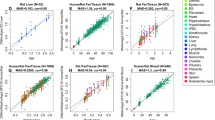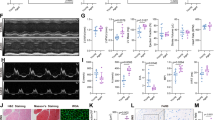Abstract
With the increase in blood viscosity, the blood circulation resistance will increase when animals are in hypoxia. However, these phenomenons do not appear in hypoxic-adapted animals. Eospalax fontanierii is a subterranean rodent and is an ideal species for research in hypoxia adaptation. Eighteen healthy adult E. fontanierii individuals were equally divided into three groups that were exposed to 21% O2 for 1 week, 10.5% O2 for 44 h, and 6.5% O2 for 6 h, and then, the hearts were collected for transcriptome sequencing. After differentially expressed analysis, fibrinogen genes were selected for qPCR and Western blot verification. Eighteen healthy adult Sprague-Dawley rats (SD rats) were treated with the same oxygen concentrations, and their hearts were simultaneously subjected to qPCR. The quantitative real-time PCR and Western blot results were completely opposite to those of the rats. E. fontanierii fibrinogen mRNA was significantly downregulated when expressed under the conditions of 10.5% and 6.5% O2 compared with 21% O2. Correspondingly, fibrinogen mRNA in E. fontanierii was expressed at lower levels than SD rats in 10.5% and 6.5% O2. After tail-cutting experiment, the results showed that the coagulation rate of E. fontanierii was slowed down under hypoxic conditions. These results showed that E. fontanierii may downregulate the expression of fibrinogen mRNA in hypoxia to reduce the aggregation of red blood cells and platelets in plasma, which may prevent blood from becoming overly viscous, and at the same time, reduce blood circulation resistance and the probability of thrombosis in hypoxia to protect the heart.










Similar content being viewed by others
Data availability
The raw data and processed files of this article are available in the NCBI Gene Expression Omnibus with GEO Series Accession Number PRJNA497961.
References
Baglia FA, Walsh PN (2000) Thrombin-mediated feedback activation of factor XI on the activated platelet surface is preferred over contact activation by factor XIIa or factor XIa. J Biol Chem 275(27):20514–20519
Bagoly Z, Koncz Z et al (2012) Factor XIII, clot structure, thrombosis. Thromb Res 129(3):382–387
Becker RC, Cannon CP et al (1996) Prognostic value of plasma fibrinogen concentration in patients with unstable angina and non-Q-wave myocardial infarction (TIMI IIIB Trial). Am J Cardiol 78(2):142–147
Begall S, Burda H et al (2007) Subterranean rodents: news from underground. Springer, Berlin
Bishop JJ, Nance PR et al (2001) Effect of erythrocyte aggregation on velocity profiles in venules. Am J Physiol Heart Circ Physiol 280(1):H222
Bradford A (2007) The role of hypoxia and platelets in air travel-related venous thromboembolism. Curr Pharm Des 13(26):2668–2672
Bradford A (2007) The role of hypoxia and platelets in air travel-related venous thromboembolism. Curr Pharm Des 13(26):2668
Brill A, Suidan GL et al (2013) Hypoxia, such as encountered at high altitude, promotes deep vein thrombosis in mice. J Thromb Haemost 11(9):1773–1775
Buffenstein R (1996) Ecophysiological responses to a subterranean habitat; a Bathyergid perspective. Mammalia 60(4):591–606
Carvalho FA, Carneiro FA et al (2012) Dengue virus capsid protein binding to hepatic lipid droplets (LD) is potassium ion dependent and is mediated by LD surface proteins. J Virol 86(4):2096
Chae CU, Lee RT et al (2001) Blood pressure and inflammation in apparently healthy men. Hypertension 38(3):399–403
Chen TT, Zhou X et al (2011) Relationship between α-actinin and cardiac function in rats with myocardial ischemia–reperfusion. J South Med Univ 31(6):970
Chung DW, Harris JE et al (1990) Nucleotide sequences of the three genes coding for human fibrinogen. Oxyg Transp Tissue XXXIII 281:39–48
Chung DW, Rixon MW et al (2010) Cloning of fibrinogen genes and their cDNA. Ann NY Acad Sci 408(1):449–456
Clarke R, Emberson JR et al (2008) Biomarkers of inflammation predict both vascular and non-vascular mortality in older men. Eur Heart J 29(6):800
Davie EW (2003) A brief historical review of the waterfall/cascade of blood coagulation. J Biol Chem 278(51):50819–50832
De CR, Akhavan S et al (2004) A natural prothrombin mutant reveals an unexpected influence of A-chain structure on the activity of human alpha-thrombin. J Biol Chem 279(13):13035–13043
Duprez DA, Somasundaram PE et al (2015) Relationship between C-reactive protein and arterial stiffness in an asymptomatic population. J Hum Hypertens 19(7):515
Fang X et al (2014) Adaptations to a subterranean environment and longevity revealed by the analysis of mole rat genomes. Cell Rep 8(5):1354–1364
Fukujima MM, Martinez TL et al (1997) Fibrinogen as independent risk factor for ischemic stroke. Arq neuro-psiquiatr 55(4):737
Grimes KM, Voorhees A et al (2014) Cardiac function of the naked mole-rat: ecophysiological responses to working underground. Am J Physiol Heart Circ Physiol 306(5):H730
Guedes AF, Carvalho FA et al (2016) Atomic force microscopy as a tool to evaluate the risk of cardiovascular diseases in patients. Nat Nanotechnol 11(8):687–692
Gulledge AA, Rezaee F et al (2001) A novel transgenic mouse model of hyperfibrinogenemia. Thromb Haemost 86(2):511
Hoeper MM, Granton J (2011) Intensive care unit management of patients with severe pulmonary hypertension and right heart failure. Am J Respir Crit Care Med 184(10):1114–1124
Johansen K, Lykkeboe G et al (1976) Blood respiratory properties in the naked mole rat Heterocephalus glaber, a mammal of low body temperature. Respir Physiol 28(3):303–314
Kim S, Popel AS et al (2005) Aggregate formation of erythrocytes in postcapillary venules. Am J Physiol Heart Circ Physiol 288(2):H584–H590
Kuipers S, Cannegieter SC et al (2007) The absolute risk of venous thrombosis after air travel: a cohort study of 8,755 employees of international organisations. PLoS Med 4(9):e290
London GM, Marchais SJ et al (2003) Inflammation, arteriosclerosis, and cardiovascular therapy in hemodialysis patients. Kidney Int 63(84):S88–S93
Lord ST (2011) Molecular mechanisms affecting fibrin structure and stability. Arterioscler Thromb Vasc Biol 31(3):494–499
Mäkipetäjä KM, Hall FC et al (2006) Rheumatoid arthritis is associated with increased aortic pulse-wave velocity, which is reduced by anti-tumor necrosis factor-alpha therapy. Circulation 114(11):1185–1192
Mahmud A, Feely J (2005) Arterial stiffness is related to systemic inflammation in essential hypertension. Hypertension 46(5):1118–1122
Martini WZ, Dubick MA (2015) Fibrinogen concentrate administration inhibits endogenous fibrinogen synthesis in pigs after traumatic hemorrhage. J Trauma Acute Care Surg 79(4):540–547; discussion 547–548. https://doi.org/10.1097/ta.0000000000000819
Menegatti M, Peyvandi F (2009) Factor X deficiency. Semin Thromb Hemost 35(04):407–415
Moore LG, Harrison GL et al (1986) Low acute hypoxic ventilatory response and hypoxic depression in acute altitude sickness. J Appl Physiol 60(4):1407
Neerman AM, De Moerloose P, Bridel C et al (2000) Mutations in the fibrinogen aalpha gene account for the majority of cases of congenital afibrinogenemia. Blood 96(1):149
Ninivaggi M, Laat MD et al (2015) Hypoxia induces a prothrombotic state independently of the physical activity. PLoS ONE 10(10):e0141797
Prabhakar NR, Semenza GL (2012) Adaptive and maladaptive cardiorespiratory responses to continuous and intermittent hypoxia mediated by hypoxia-inducible factors 1 and 2. Physiol Rev 92(3):967
Rosendaal FR (2002) Air travel and thrombosis. Pathophysiol Haemost Thromb 32(5–6):341–342
Ross RL, Beck AW (2014) Fibrinogen and catheter-directed thrombolysis. Semin Vasc Surg 27(3–4):182–195
Sabio JM, Vargas-Hitos JA et al (2010) Correlation of asymptomatic hyperuricaemia and serum uric acid levels with arterial stiffness in women with systemic lupus erythematosus without clinically evident atherosclerotic cardiovascular disease. Lupus 19(5):591
Schouten F, Twisk JW et al (2011) Increases in central fat mass and decreases in peripheral fat mass are associated with accelerated arterial stiffening in healthy adults: the Amsterdam Growth and Health Longitudinal Study. Am J Clin Nutr 94(1):40–48
Semenza GL (2014) Hypoxia-inducible factor 1 and cardiovascular disease. Annu Rev Physiol 76(1):39
Sjöblom B, Salmazo A et al (2008) α-Actinin structure and regulation. Cell Mol Life Sci 65(17):2688
Sun GQ, Li YB (2012) Significance of changes in blood lipid, serum uric acid, fibrinogen and platelet levels in patients with myocardial infarction. Mod Prev Med 39(22):5924–5925
Suttontyrrell K, Najjar SS et al (2005) Elevated aortic pulse wave velocity, a marker of arterial stiffness, predicts cardiovascular events in well-functioning older adults. Circulation 111(25):3384–3390
Tilley R, Mackman N (2006) Tissue factor in hemostasis and thrombosis. Semin Thromb Hemost 32(01):005–010
Vlachopoulos C, Dima I et al (2005) Acute systemic inflammation increases arterial stiffness and decreases wave reflections in healthy individuals. Circulation 112(14):2193
Walsh PN (2003) Roles of factor XI, platelets and tissue factor-initiated blood coagulation. J Thromb Haemost 1(10):2081
Weisel JW, Litvinov RI (2017) Fibrin formation, structure and properties. Subcell Biochem. https://doi.org/10.1007/978-3-319-49674-0_13
Wood JP, Ellery PE et al (2014) Biology of tissue factor pathway inhibitor. Blood 123(19):2934–2943
Yarnell JW, Baker IA et al (1991) Fibrinogen, viscosity, and white blood cell count are major risk factors for ischemic heart disease. The Caerphilly and Speedwell Collaborative Heart Disease Studies. Circulation 83(3):836–844
Zarndt R, Piloto S et al (2015) Cardiac responses to hypoxia and reoxygenation in Drosophila. Am J Physiol Regul Integr Comp Physiol 309(11):1347–1357
Zou ZS, Liu ZG et al (2002) Detection of coagulation factor V in patients with severe hepatitis and its clinical significance. Infect Dis Inf 17(3):274–276
Acknowledgements
This study was supported by Grants from the National Nature Science Foundation of China (Grant Nos. 30670360 and 31770333) and Nature Science Foundation of Shaanxi Province, China (No. 2016JM3024).
Author information
Authors and Affiliations
Contributions
JG Li and JP He conceived and designed the study. JY Lin and Q Zhao conducted most of the experiments with the help of LL Xu, GL Li, ZQ Hao and JP He provided regular timely suggestions during the course of the experimental work. LL Xu and JY Lin participated in several of the experiments. Q Zhao also helped LL Xu in preparing the first draft of the manuscript, which was edited and finalized by LL Xu and ZQ Hao with the help of GL Li, JP He, and JG Li. BJ Zhang provided the experimental materials.
Corresponding authors
Ethics declarations
Conflict of interest
All of the authors declare that there are no conflicts of interest.
Ethical approval
All the animals were treated humanely according to guidelines of the Care and Use of Laboratory Animals of China, and all the procedures were approved by the Animal Care and Use Committee of Shaanxi Normal University.
Additional information
Publisher’s Note
Springer Nature remains neutral with regard to jurisdictional claims in published maps and institutional affiliations.
Rights and permissions
About this article
Cite this article
Xu, L., Hao, Z., Lin, J. et al. Transcriptome sequencing of Eospalax fontanierii to determine hypoxia regulation of cardiac fibrinogen. Mol Biol Rep 46, 5671–5683 (2019). https://doi.org/10.1007/s11033-019-04690-1
Received:
Accepted:
Published:
Issue Date:
DOI: https://doi.org/10.1007/s11033-019-04690-1




